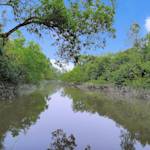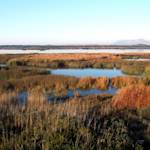Myanmar Mangroves
2014 CE • Myanmar
"Myanmar is home to the third most extensive area of mangrove ecosystems in Asia. Mangroves form the foundation of a highly productive and biologically rich ecosystem which provides a home and feeding ground for a wide range of species, many of which are endangered", such as the Irrawaddy Dolphin. The mangroves are also home to high populations of water and migratory birds such as cormorants, herons, sand plovers, and gulls. "Although mangroves make up less than one percent of all tropical forests worldwide, they are highly valuable ecosystems, providing an array of essential goods and services which contribute significantly to the livelihoods, well-being and security of coastal communities . . . Myanmar has been subject to one of the world’s highest rates of mangrove clearance, with annual losses estimated at 2.2 percent of their total area between 2000-2014, as mangroves have been converted for agriculture, city expansion, and economic development." Additionally, among the wildlife within the mangroves, the presence of several iconic mammals such as tigers, leopards, and wild dogs has drastically diminished over time as a result of poaching and habitat loss.
"Myanmar Mangroves," UN-REDD Programme.
Image: mohigan, CC BY-SA 3.0, via Wikimedia Commons


Learn about Maya Lin’s fifth and final memorial: a multi-platform science based artwork that presents an ecological history of our world - past, present, and future.

Discover ecological histories and stories of former abundance, loss, and recovery on the map of memory.

Learn how we can reduce our emissions and protect and restore species and habitats – around the world.

See how art can help us rethink the problems we face, and give us hope that each one of us can make a difference.

Help make a global memorial something personal and close to home. Share your stories of the natural world.


